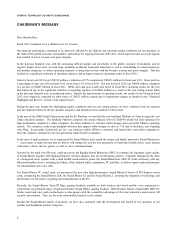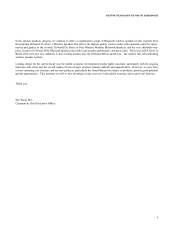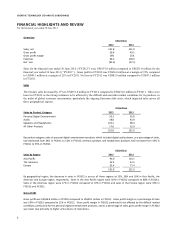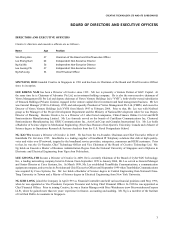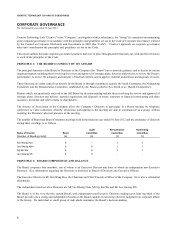Creative 2012 Annual Report Download - page 10
Download and view the complete annual report
Please find page 10 of the 2012 Creative annual report below. You can navigate through the pages in the report by either clicking on the pages listed below, or by using the keyword search tool below to find specific information within the annual report.
8
CREATIVE TECHNOLOGY LTD AND ITS SUBSIDIARIES
CORPORATE GOVERNANCE
For the nancial year ended 30 June 2012
Creative Technology Ltd (“Creative” or the “Company”, and together with its subsidiaries, the “Group”) is committed to maintaining
good corporate governance in accordance with the principles and guidelines set out in the Code of Corporate Governance released
by the Council on Corporate Disclosure and Governance in 2005 (the “Code”). Creative’s approach on corporate governance
takes into consideration the principles and guidelines set out in the Code.
This report outlines the main corporate governance practices that were in place throughout the nancial year, with specic references
to each of the principles of the Code.
PRINCIPLE 1: THE BOARD’S CONDUCT OF ITS AFFAIRS
The principal functions of the Board of Directors of the Company (the “Board”) are to provide guidance and to decide on certain
important matters, including those involving the review and approval of strategic plans, direction and policies, to review the Group’s
performance, to review the adequacy and integrity of internal controls, and to approve material acquisitions and disposals of assets.
These functions are either carried out directly by the Board or through committees, namely the Audit Committee, the Nominating
Committee and the Remuneration Committee, established by the Board (collectively referred to as “Board Committees”).
Matters which are specically reserved to the full Board for decision-making include those involving the review and approval of
strategic plans, direction and policies, material acquisitions and disposals of assets, corporate or nancial restructuring and share
issuances, dividends and other returns to shareholders.
The Articles of Association of the Company allow the Company’s Directors to participate in a Board meeting by telephone
conference or video conference whereby all persons participating in the meeting are able to communicate as a group, without
requiring the Directors’ physical presence at the meeting.
The number of Board and Board Committee meetings held in the nancial year ended 30 June 2012 and the attendance of directors
during these meetings is as follows.
(Number of Meengs Held) (6) (6) (1) (1)
Sim Wong Hoo 6 – 1 1
Lee Kheng Nam 6 6 1 1
Ng Kai Wa 6 6 1 1
Lee Gwong-Yih 6 6 - -
PRINCIPLE 2: BOARD COMPOSITION AND BALANCE
The Board comprises four members, one of whom is an Executive Director and three of whom are independent non-Executive
Directors. Key information regarding the Directors is disclosed in Board of Directors and Executive Ofcers.
The Executive Director is Mr Sim Wong Hoo, the Chairman and Chief Executive Ofcer of the Company. He is also a substantial
shareholder.
The independent non-Executive Directors are Mr Lee Kheng Nam, Mr Ng Kai Wa and Mr Lee Gwong-Yih.
The Board is of the view that the current Board, with independent non-Executive Directors making up at least one-third of the
Board, provides for a strong and independent element on the Board capable of exercising objective judgement on corporate affairs
of the Group. No individual or small group of individuals dominates the Board’s decision-making.




